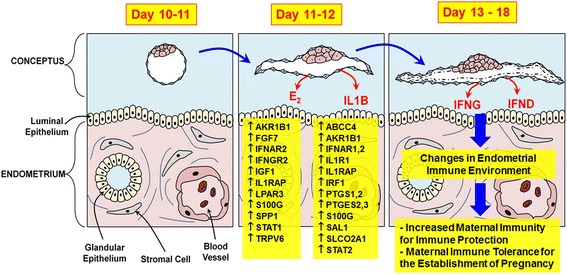Fig. 3.

Schematic illustration of the effects of conceptus-derived factors on the expression of genes and possible functions in the endometrium of the porcine uterus during early pregnancy in pigs. Estrogens (E2) and interleukin-1β (IL1B) are secreted by the elongated filamentous conceptus into the uterine lumen on d 11-12 of pregnancy and affect the expression of many endometrial genes, including Aldo-keto reductase 1B1 (AKR1B1), ATP-binding cassette sub-family C member 4 (ABCC4), prostaglandin (PG)-endoperoxide synthases 1 and 2 (PTGS1, PTGS2), and solute carrier organic anion transporter family, member 2A1 (SLCO2A1), that are involved in PG synthesis and transport, leading to the maternal recognition of pregnancy. In addition, E2 and IL1B induce endometrial expression of several interferon (IFN) signaling molecules, including receptors for type I and type II IFNs and IFN-regulatory factor 1 (IRF1) and signal transducers and signal transduction and activator of transcription 1 (STAT1), to prime the endometrium to increase its responsiveness to the actions of IFN-γ (IFNG) and IFN-δ (IFND), which are secreted by the conceptus following its production of estrogen and IL1B on d 12-20 of pregnancy. IFNG and IFND change the endometrial immune environment, increasing maternal immunity for protection and achieving maternal immune tolerance to the semi-allograft conceptus
